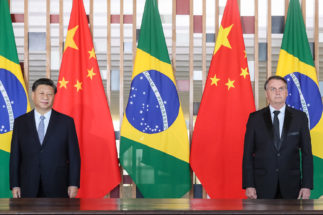In the next five years, China will overhaul its environmental governance to deliver a system that is “clear in its direction”, “scientific in decision making”, “strong in enforcement”, “effective in its incentives” and “wide in participation”, according to guidance issued on 3 March by the Central Committee and the State Council.
The guidelines follow a call from the Central Committee last November to “promote the modernisation of China’s governance systems and capacities”. They are built around the principles of leadership by the Party, multi-stakeholder governance, market orientation and law-based governance, and include 28 key points for reform across seven fields including government supervision, corporate responsibility and public participation.
To avoid making the old mistake of relaxing protections for the sake of a boost to the economy we need to… make more use of the market and public oversight.”
In 2012, at the start of Xi Jinping’s presidency, Ma Jun, director of the Institute for Public and Environmental Affairs (IPE), wrote of his expectations for reform of China’s environmental governance in the coming decade. A leader of the country’s environmental NGO sector, since 2012 Ma has been working to foster greater transparency. To that end, the IPE has produced the Blue Map app so the public can check live pollution data from nearby factories, as well as an annual evaluation of government environmental transparency. These are regarded as models of positive interaction between government and the public on governance.
China Dialogue caught up with Ma to discuss the new guidance.
Where would you place these guidelines within China’s existing environmental legislation and policies?
We all know that a joint guidance from the Central Committee and the State Council is hugely important, as it reflects the thinking of China’s top leadership. These views will gradually be embodied as principles in all aspects of legislation, policy and implementation.
What does “modernisation” mean here?
This is new language, linked with recent calls to modernise national governance in general. In terms of actual content, the guidelines feature some new ideas and alignment with best environmental governance practices worldwide.
In China, governance of the environment differs from that of other areas. The relevant government departments, legislative bodies and NGOs started experimenting with “public participation” and “multi-stakeholder governance” relatively early; good practices have been built up based on resolving practical issues. The guidelines do a good job of affirming these practices, such as transparency of environmental information and green financing, but also propose directions for future development.
The guidelines identify seven major systems and assign responsibilities to the various stakeholders (including government, business and the public). They make particular mention of the use of the market and public participation – which are steps forward.
In 2012, you wrote that a new environmental governance system should be founded on the public’s procedural rights: to be informed, to participate and to judicial redress. But these guidelines set out in detail the responsibilities of stakeholders. How do rights-based and responsibilities-based systems differ?
When we looked at the environmental sector nearly ten years ago, we saw mutual dependence and competition between the government, businesses and the public – with the public weakest. The public has an important role to play in effective environmental governance, but back then there were no channels for that to happen. Procedural rights are very important, in particular the right to be informed. If the public can’t get information, they can’t participate effectively.
In the last decade, we’ve seen historic progress on the transparency of environmental information. The relationships between government, businesses and the public have gradually become more positive. The public has access to data, which it uses to play a hugely beneficial role in environmental governance. Environmental information doesn’t just help members of the public protect themselves. It means they can monitor polluters, bring environmental cases to court and participate in decision-making processes such as the approval of environmental impact assessments.
Environmental rights are a part of human rights, the starting point for public participation in environmental governance and the foundation of a system of environmental legislation. The 2015 revision of China’s environmental protection law affirmed the public’s right to be informed, to participate and to hold actors accountable. The new guidelines follow on from that, but are more focused on the operational level and on practical environmental management plans. They are results-orientated and emphasise stakeholders’ responsibilities during implementation. Meanwhile, though the guidelines don’t refer to “rights” when discussing public supervisory mechanisms, recognition of them is implicit.
The guidelines are very specific on disclosure of corporate information, but do not have much to say on government information. What’s your view on this?
The guidelines follow on from other rules and policies. There are already regulations and policies in place for openness of government information, and our ongoing tracking and evaluation has found big improvements on this in recent years. But business transparency hasn’t improved and is nowhere near adequate for the needs of environmental governance. So that focus on business is very necessary.
Also, environmental information from businesses is one part of government transparency. The public can’t be expected to go and extract information from company after company in order to exercise its right to be informed. Ultimately, it has to be the government that makes sure businesses are fulfilling their obligations, and have an unavoidable responsibility to put policies and systems in place that they follow.
Do you see any weaknesses in the guidelines on transparency?
The content of the guidelines reflects, rather than goes beyond, existing regulations. For example, they say companies should publish lists of pollutants, how they are released and the standards applied – but not the amount of pollutants released. We think the Ministry of Ecology and Environment should guide companies towards more comprehensive transparency – including amounts of pollutants, but also energy consumption and emissions of greenhouse gases.
Also, the market-based governance mechanisms featured in the guidelines – pollution trading, environmental credit ratings, etc – won’t work properly without full company-level info.
We’d like to see a little less governance by individuals. Modern environmental governance must be built on the rule of law.”
You’ve emphasised that information is key to market-based governance. The guidelines specifically call for an environmental governance “market system”, with the private sector involved, including pollution trading and the development of green financing. Why is the market so important at this point?
Market participation in environmental governance is the result of openness of information and public participation. Interactions between stakeholders promote market mechanisms. For example, we’ve recently seen state-owned banks trial the IPE’s big-data-based system for assessing corporate environmental credit ratings, using it to monitor the environmental performance of companies over the period of a loan. That data is also now being used in the issuing of green bonds.
It’s key that the guidelines emphasise the role of markets. The past five years have seen China bolster environmental regulations, with a large part of this involving building systems for holding officials to account and examining their performance. This has meant government at all levels working hard to tackle environmental pollution. But the impact of the trade war with the US and the coronavirus mean unprecedented pressure on the Chinese economy. Given this, it will be hard to maintain the intensity of the top-down government-led approach to environmental governance of recent years. Some localities want to relax environmental oversight, and we can assume a huge economic stimulus is on the way.
We’re currently at a crossroads for environmental protection and climate policy. To avoid making the old mistake of relaxing protections for the sake of a boost to the economy, we need to explore ways to build a modern environmental governance system, making more use of the market and public oversight. Because market-based environmental governance has the smallest economic impact: it establishes fair competition and allows the strongest to survive, punishing polluters and encouraging green businesses. China urgently needs an economic recovery, and market solutions may offer crucial help in balancing environmental protection with development. But this will require oversight by both the government and the public, or we risk market failures.
The guidelines also stress “Party leadership”. How is Party involvement in environmental governance significant?
At all levels of government in China, the Party Secretaries are effectively in control, while their peers in administrative roles (governors, mayors, county chiefs, etc) are responsible for the day-to-day running of business. Now Party officials are to share responsibility for the environment, rather than simply holding administrative officials to account. In practice this will mean stronger accountability and implementation of environmental policy.
But we also note the guidelines include the principle of “governance by rule of law”. These two aspects need to be considered together. Powerful individuals with authority can act quicker and resolutely, but they are also more likely to go astray, resulting in excessive or overly uniform approaches. We’d like to see a little less governance by individuals. Modern environmental governance must be built on the rule of law.







![Downstream of the dam site of the 50 MW Upper Marsyangdi A hydro project in Nygdi. A stretch of about six kilometres has gone dry [All images by: Nabin Baral]](https://dialogue.earth/content/uploads/2020/03/Dying-Marsyangdi-5-300x200.jpg)

